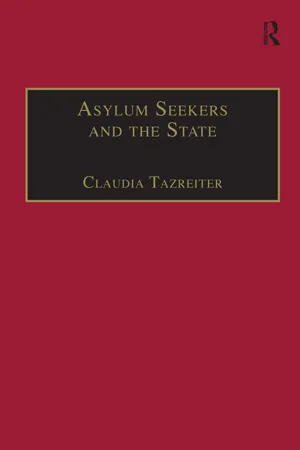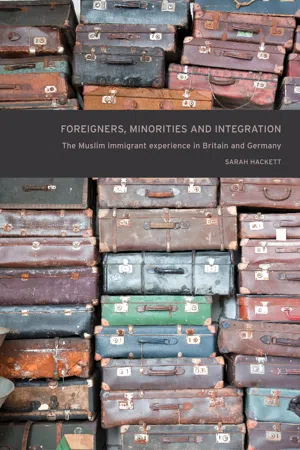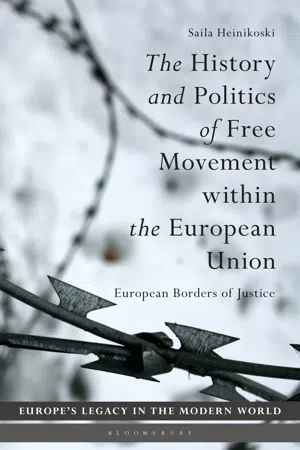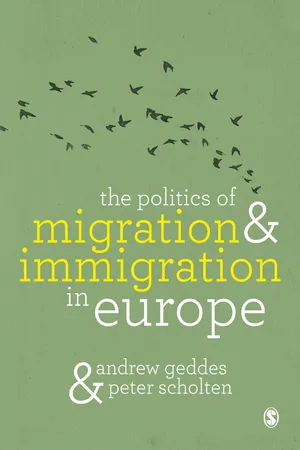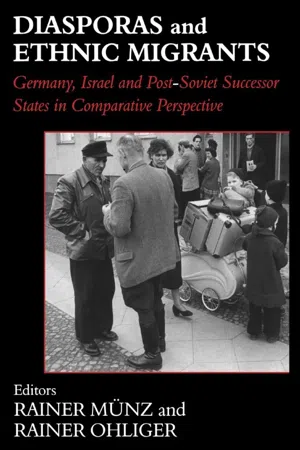History
German Immigration
German immigration refers to the movement of people from Germany to other countries, particularly the United States, during various periods of history. Significant waves of German immigration occurred in the 19th and early 20th centuries, contributing to the cultural and economic development of the receiving countries. German immigrants often settled in communities where they preserved their language, traditions, and customs.
Written by Perlego with AI-assistance
Related key terms
8 Key excerpts on "German Immigration"
- eBook - ePub
Asylum Seekers and the State
The Politics of Protection in a Security-Conscious World
- Claudia Tazreiter(Author)
- 2017(Publication Date)
- Routledge(Publisher)
We must bear in mind that Germany has by far the largest foreign population in Western Europe - at some 9 per cent of a population of 82 million: this equates to over 7.3 million non-Germans living in Germany. Unlike the 'classic countries of immigration' such as Australia, Canada or the United States, which developed through large-scale, yet controlled waves of quota immigration, Germany and many other European countries have not considered themselves as countries of immigration, with the consequence that there is a reluctance and indeed at times violent resistance to dealing with the social consequences of the influx of migrants. Public opinion polls indicate that over 60 per cent of Germans want immigration stopped or reduced, and confirm a wide-held belief that at least some of the foreigners living in Germany will return to their country of origin (Martin 1994; 188). Some of this sentiment is reflected in the small but significant growth of support for far-right political parties in Germany, particularly since unification in 1990.However, the large-scale migration movements are not a new phenomenon in Germany. The history of immigration and emigration remains an informative undercurrent to present-day policies as well as public attitudes to newcomers, including the arrival of refugees and asylum seekers. Refugees and asylum seekers enter a 'general terrain' of 'aliens', of non-nationals, and therefore by inference must negotiate the same or similar tensions and exclusions experienced by other newcomers. When we look at history it becomes clear that Germany has experienced a myriad of cross-border migrations:. . . emigration, immigration, and transit movements; the labour migration of Germans across German borders and the influx of foreign labour into Germany; flight and forced migration of Germans into foreign countries, of foreigners into Germany, and of Germans as victims and offenders within and outside German national borders. In addition to the movement of people across borders, German history has also seen the movement of borders across people(Bade 1997; 2).Through the collective memory of successive generations, Germans are familiar with both the experience of settling in new countries, as well as with others settling in German territory. From 1816 to 1914, for instance, it is estimated that some 5.5 million Germans emigrated to the United States and since 1914 that number was supplemented by another 1.5 million (Bade 1997; 5). Moreover, it is significant in light of contemporary perceptions of an 'asylum problem' in Germany, to consider that the motivation for this transatlantic mass emigration throughout the nineteenth century was social and economic - instigated most significantly by a lack of work opportunities, related to the transition from an agrarian to an industrial society. In today's understanding of forced migration, these early German emigrants were 'economic refugees' (Wirtschaftsflüchtlinge - eBook - ePub
Foreigners, minorities and integration
The Muslim immigrant experience in Britain and Germany
- Sarah Hackett(Author)
- 2015(Publication Date)
- Manchester University Press(Publisher)
IntroductionA history of immigration to modern Britain and Germany: national and local perspectives The national contextsThe history of immigration to Britain and West Germany in the postwar period has traditionally been seen as one of contrasts.1 The reasons for this were not new to the post-1945 era, but rather were entrenched in both countries’ histories. Britain has often been perceived as a country with a long tradition of migration and one that was perhaps destined to become multi-racial. The black soldiers who fought in the Roman armies that invaded Britain, the migrants who arrived from the Indian subcontinent during the 1600s and 1700s, and the Yemeni seamen who settled in dockland areas from the mid-nineteenth century act as testimony to this.2 Furthermore, the British Empire ensured that people from all corners of the globe felt a connection with the ‘mother country’. Indeed Britain’s role as the imperial hub for a quarter of the world’s surface guaranteed a widespread familiarity with the British language, education system and way of life.3 Germany, by contrast, is a young country that, following its unification in 1871, displayed both nationalistic and racial ideology. In its short history, the notions of race and minority groups have never been far from its political agenda, whether in the form of racial hierarchy, exclusion and persecution, or xenophobia and discrimination.4Other contrasts between Britain and Germany’s immigration histories also exist and have been well documented in the historiography. Starting with its unification, Germany implemented a policy of Germanisation, the legacy of which lasted throughout the twentieth century. Furthermore, its völkisch ethno-cultural nationhood arguably shaped a national identity that limited the recognition of foreigners in the country. This was further accentuated by its status as the only major European immigration country with a pure jus sanguinis notion of citizenship. Britain’s imperial policy, on the contrary, whilst undoubtedly based on a racial hierarchy to some extent, never widely consisted of overt racial persecution. Furthermore, British citizenship was comparably more accessible as a result of the concept of jus soli , allowing immigrants to become integrated. In essence, by the second half of the twentieth century, Britain had a strong multi-ethnic tradition to act as the foundation for post-1945 immigration whilst Germany did not.5 - eBook - ePub
Immigration in the 21st Century
The Comparative Politics of Immigration Policy
- Terri E. Givens, Rachel Navarre, Pete Mohanty(Authors)
- 2020(Publication Date)
- Routledge(Publisher)
5Immigration POLITICS
Germany and Newer Countries of Immigration
Introduction
As noted in Chapter 4 , the aftermath of World War II led to immigration from former colonies to France and Britain. For other countries that did not have the same kind of colonial ties, the first flows after the war came from other parts of Europe, but as countries like Germany began to recover from the war, they reached out to other countries like Turkey for the workers they needed to rebuild. These “newer” countries of immigration initially focused on labor flows, particularly during the 1950s and 1960s. It wasn’t until the 1970s and 1980s that they began to grapple with the fact that communities had developed, and the laborers had become settlers.Germany
After World War II, Germany struggled to recover from the devastation wrought by the war. Since World War II, Germany has received over 20 million immigrants, refugees, and expellees (Muenz and Ulrich 1998). However, as this section shows, most of these immigrants were never perceived as foreigners because they were ethno-cultural Germans. By contrast, at the peak of labor migration in 1973, the 2.6 millionGastarbeiter (guest workers), many of whom eventually became permanent settlers, were perceived as foreigners. In recent years, Germany’s self-understanding has come under increasing assault. German governments have grappled with reconciling the traditional conception of citizenship with modern demands of the economy for highly skilled workers and the integration of non-ethnic Germans.Two relatively recent historical reviews of German Immigration policy development come from Joppke (1999) in Migration and the Nation-State and Rita Chin (2006) in The Guest Worker Question in Postwar Germany - eBook - ePub
International Migration Research
Constructions, Omissions and the Promises of Interdisciplinarity
- Ewa Morawska, Michael Bommes(Authors)
- 2017(Publication Date)
- Routledge(Publisher)
To be sure, migration ought not to be regarded as a one-way street. In the past, European migration did not only consist of various circulating movements, such as the migration of agricultural servants, urban journeymen, seasonal labourers and the like. Immigration and emigration were very often strongly interwoven. For example, southwestern Germany in the 18th and early 19th centuries not only sent hundreds of thousands of emigrants to north America and eastern Europe, but also attracted agricultural servants, seasonal stonemasons and bricklayers from the Swiss and Austrian Alps. International migration in the German Empire in the late 19th and early 20th centuries was characterized both by mass emigration to the Americas and mass immigration from Poland and parts of the Habsburg Empire. Germany showed a double character of ‘emigration land’ and ‘labor importer land’ (Bade, 1992a; Klessmann, 1992).In addition, return migration constitutes a considerable part of domestic and international mass migration (Morawska, 1987, pp. 228ff). It is well-known that between one third and one half of all Europeans who emigrated overseas later returned, and some of them subsequently ‘re-emigrated’ (Morawska, 1990, p. 195). Even the migrational relationships between industrial and agricultural regions were by no means one-way streets well into the late 19th century. Industrial laborers migrated to agricultural areas during the summer season if higher wages beckoned there, and for many of these individuals, returning to the land after reaching the age of 40 or 50 was a normal rite of passage in their life course (Postel-Vinay, 1994; Ehmer, 1994). Migration consists of a wide variety of parallel and opposing, overlapping and contradictory movements. The classic Overpopulation theory’ is conceptually incapable of embracing the fluidity and complexity of migratory movements.4Malthusian Arguments as a Tautological Circle
The main methodological problem goes far beyond the field of migration research. It is inherent in the very concept of Overpopulation’. The intellectual roots of this concept go back to the English clergyman and economist Thomas Robert Malthus, who has been enormously influential in demographic thought. In his ‘Essay on the Principle of Population’ (1798) he put forth a ‘law of population’, according to which population tended to rise much more rapidly than the production of foodstuffs could be increased. As a result, there emerges a surplus and superfluous population which threatens the entire society with poverty and hunger. According to Malthus, there are two possibilities of reestablishing an equilibrium between population and food supply. The first of these – functioning spontaneously and according to natural law – consists of famines and other catastrophes that reduce excess population. Malthus called this a ‘positive check’. The second possibility entailed voluntary abstinence as a means of avoiding an increase in population, the so-called ‘preventive check’. Whoever was not in a position to provide food for a family should refrain from marriage and reproduction. This second alternative could bring about the establishment of a long-term equilibrium between population and economic resources, and guarantee a state of social harmony. Migration played no particularly significant role in Malthus’ work, but it appeared as an additional possibility of adjusting to available foodstuffs for a society whose population had grown too quickly. According to his theory, ‘overpopulation’ was reached when the population’s per capita economic output fell below the subsistence level. A series of catastrophes and a high mortality rate would ensue. - eBook - ePub
The History and Politics of Free Movement within the European Union
European Borders of Justice
- Saila Heinikoski(Author)
- 2020(Publication Date)
- Bloomsbury Academic(Publisher)
2015 ).In addition to labour migration, the post-war migration policy of Germany was characterized by the so-called Aussiedler (resettler) migration, in which ethnic Germans from the Eastern Europe were provided the right to migrate to Germany (Panagiotidis 2016 : 210). Most of these migrants, who received German citizenship almost automatically, came from Poland (62 per cent), and 15 per cent or 206,000 came from Romania (Münz and Ulrich 1999 : 24). This was not a case of temporary labour but permanent settlement and citizenship, which was granted to those who were considered to represent the German Volkstum . The criteria, however, were fluctuating, varying from German language skills, ethnic endogamy and political convictions (Panagiotidis 2016 : 220).Germany only issued its first immigration law in 2005 in the post-9/11 climate, which caused fierce debates between the centre-left and the centre-right parties. In the end, the migration debate became to be characterized by the rational debate linked to labour market and by the more sentiment-related discourse related to national interests and identity (Schmidtke 2015 : 384–5). These two strands are also visible in the contemporary free movement debates, though with the rational labour market rhetoric prevailing.These policies illustrate the approach towards the nation and outsiders, in which even after the Nazi period, the idea of a unified people and temporary migration prevailed. As discussed in more detail in the following chapter, the idea of guest workers and circular migration still prevail in the contemporary German mobility discourses, even with regard to the mobility of EU citizens. The idea is to gain benefits by importing labour from other countries, while simultaneously providing the possibility for Germans to move temporarily in other EU countries to gather experience. Even though we can observe a sense of community and solidarity towards other EU citizens in the German discourses, the prevailing idea seems to be to receive benefits from labour originating from other EU countries. - Andrew Geddes, Peter Scholten(Authors)
- 2016(Publication Date)
- SAGE Publications Ltd(Publisher)
de facto immigration because otherwise there would be no point raising it’ (Joppke, 1999: 65). The underlying reasons for this were linked to pre-unification West German history as a provisional state and incomplete nation, geared to the recovery of national unity, which was achieved after reunification with East Germany in 1990.Table 4.1 provides an overview of net migration to Germany between 1991 and 2014 and captures fluctuations in numbers by showing the peak that occurred in the early 1990s and again in the 2010s. These peaks are linked to a significant degree to large flows of asylum seekers and refugees, which hit high levels in the 1990s and again in the 2010s due to flows from Kosovo, ex-Yugoslavia and the effects of instability in North Africa and the Middle East. Also, other forms of migration have been very important in the German case, such as that by ethnic Germans (Aussiedler) in the 1990s and movement by people from other EU member states since the 2000s.Source: German Statistics Office (www.destatis.de/EN/FactsFigures/SocietyState/Population/Migration/Tables/MigrationTotal.html )Immigration to a ‘non-immigration country’
Following reunification in 1989, the Federal Republic of Germany reached the end of what Thränhardt (1999) called a provisional period after the creation of East and West Germany in 1949. During this time unique impediments were placed on the capacity of West Germany to regulate international migration. The legacy of migration by guestworkers, relatively liberal asylum provisions and a right to return for ethnic Germans (Aussiedler- eBook - ePub
- Cynthia Bansak, Nicole B. Simpson, Madeline Zavodny(Authors)
- 2015(Publication Date)
- Routledge(Publisher)
Political and social factors also affect the decision to become an immigrant. Some of these factors are intertwined with economic factors. For example, corruption may push some people who want to run a business but are unable or unwilling to pay the bribes necessary to do so into becoming immigrants. Meanwhile, enforcement of private property rights may act as a pull factor for people who want to run a business without having to worry that the government will confiscate their assets. For many immigrants, having family or friends who live abroad—what economists and sociologists call “networks”—is a pull factor. As discussed later, having a network can also enable migrants to bear migration costs and can even lower migration costs. Other political and social push factors that influence the decision to become an immigrant include discrimination, violence, political oppression and having to serve in the military in the home country.Wars and changes in national borders have caused some of the largest immigration episodes in history. The end of World War II resulted in more than nine million people migrating across Japan, Korea and the former Manchuria as the Japanese army demobilized, ethnic Japanese moved back to Japan from other parts of Asia that the country had occupied, and foreigners were deported from Japan (Araragi, 2013). At the same time, millions of ethnic Germans moved from Soviet bloc countries to Germany and Austria (Gibney and Hansen, 2005). When India was partitioned upon becoming independent from Britain in 1947, more than seven million Muslims moved to Pakistan from India, and a similar number of Hindus and Sikhs moved to India from Pakistan (Zamindar, 2013).Natural disasters and famines have also caused several major migration episodes. For example, one to two million Irish emigrated during the 1845–1852 famine, and at least another one million died (Ó Gráda and O’Rourke, 1997). More recently, emigration from Honduras tripled after Hurricane Mitch devastated that country in 1998 (Kugler and Yuksel, 2008). As sea levels rise in the coming decades because of global warming, millions of people are likely to leave low-lying countries around the globe. Other climate changes due to global warming, such as desertification and food shortages, are also likely to lead to substantial migration.Attractive amenities may lure some immigrants to particular destinations. Amenities are location-specific, immobile factors, such as beautiful scenery, a pleasant climate and a good quality of living. The desire to be near mountains, the beach or good museums may attract some immigrants, particularly wealthy people or retirees who have more leisure time to enjoy such amenities. - eBook - ePub
Diasporas and Ethnic Migrants
Germany, Israel and Russia in Comparative Perspective
- Rainer Munz, Rainer Ohliger(Authors)
- 2004(Publication Date)
- Routledge(Publisher)
Aussiedler, a high percentage of the population—about 14 per cent, and up to 40 per cent in some areas—and have ready-made leaders in émigrés, generally members of an intellectual elite, who rose to prominence as dissidents in the Soviet Union. In the Israeli case, successful mobilization has been the outcome. The post-Cold War Russian Jewish immigrants have successfully achieved parliamentary representation and influenced government policy.In Israel and Germany, both co-ethnic migrant groups receive citizenship and all associated formal rights. Each group has the legal right to become politically active within or outside the political system, nationally or on the local level, but only the Jewish immigrants to Israel have done so. Aussiedler activity, however, has been restricted to supporting roles in several rural townships. This chapter uses the lens of social movement theory to explore what factors played a role in spurring on the successful mobilization of the Jewish migrants in contrast to the non-mobilization of the German migrants.HISTORICAL BACKGROUND
The Israeli and German laws permitting co-ethnic migration differ in their fundamental nature. Established as a ‘homeland’ for Jews, Israel has always been committed to accepting all Jews in diaspora. The 1948 Law of Return is one of the cornerstones of the Israeli state, enabling all Jews1 to immigrate to Israel. Largely in response to the Cold War, rather than purely on the basis of national self-understanding, Germany passed the 1953 Federal Expellees’ and Refugees’ Law (Bundesvertriebenen-und Flüchtlingsgesetz), which covered the admission and integration of the post-war ethnic German expellees and the future admission of ethnic Germans explicitly suffering ethnically based discrimination in communist countries.Since the establishment of Israel in 1948 and the Federal Republic of Germany in 1949, migration flows of Jews to Israel and ethnic Germans to Germany have been dependent upon politics: in 1957 and 1958, and again in 1975, after the passage of the Helsinki Act, more ethnic Germans were able to leave Poland, while in 1970 the same applied to Jews from the USSR. As the Cold War ended, emigration skyrocketed.
Learn about this page
Index pages curate the most relevant extracts from our library of academic textbooks. They’ve been created using an in-house natural language model (NLM), each adding context and meaning to key research topics.
